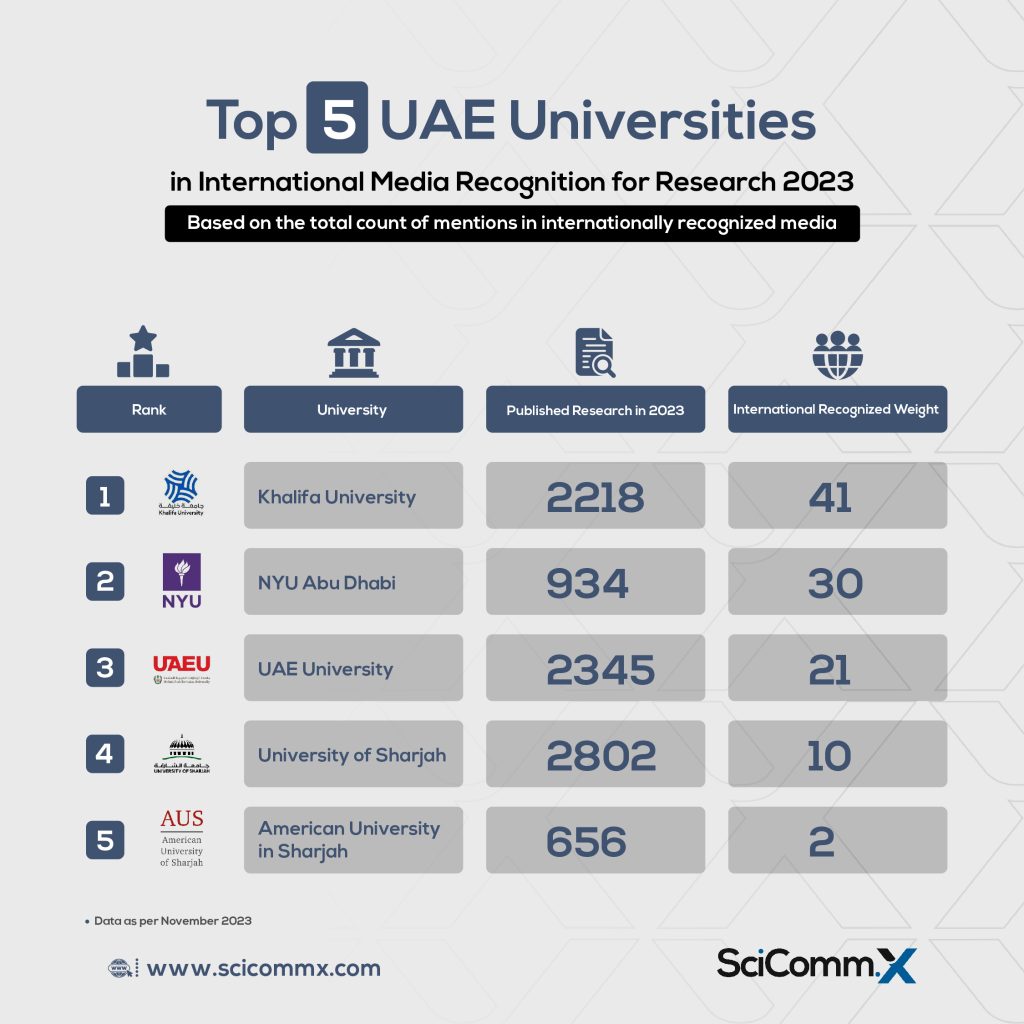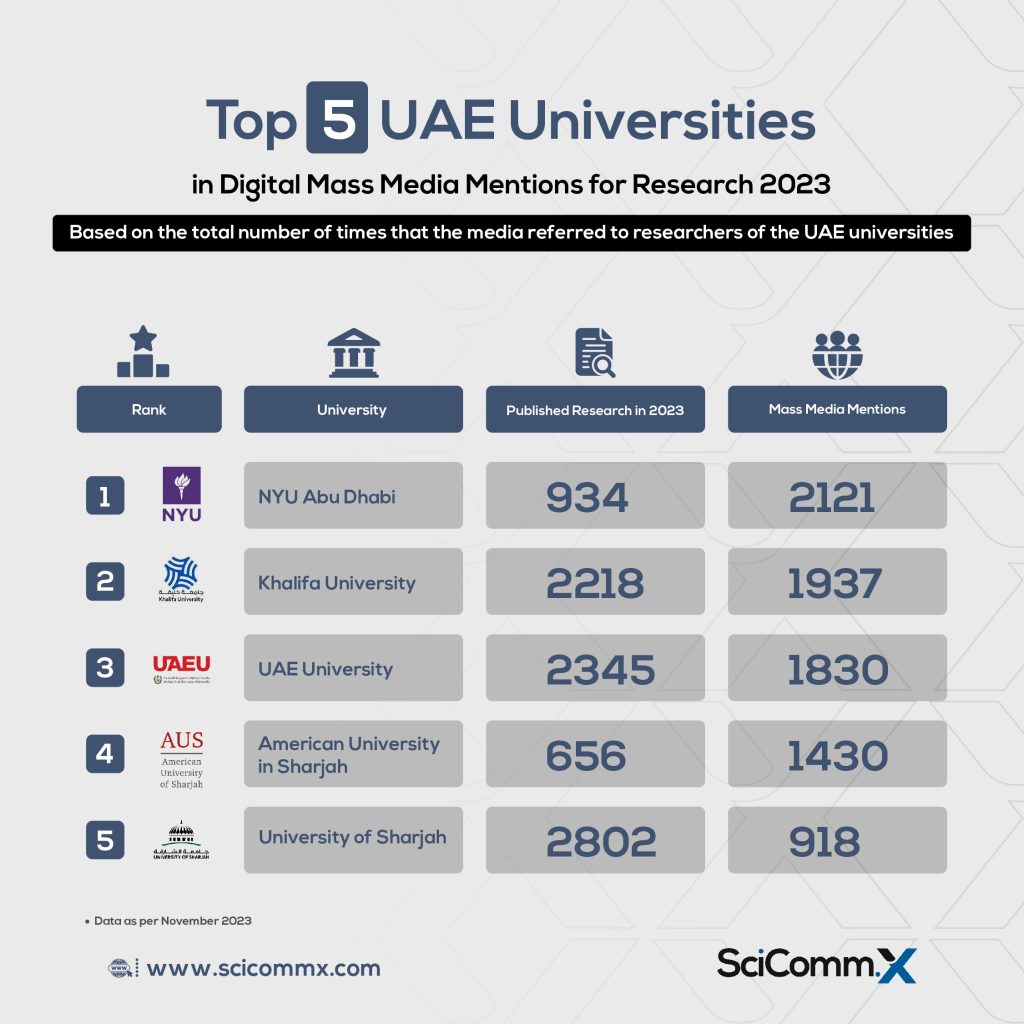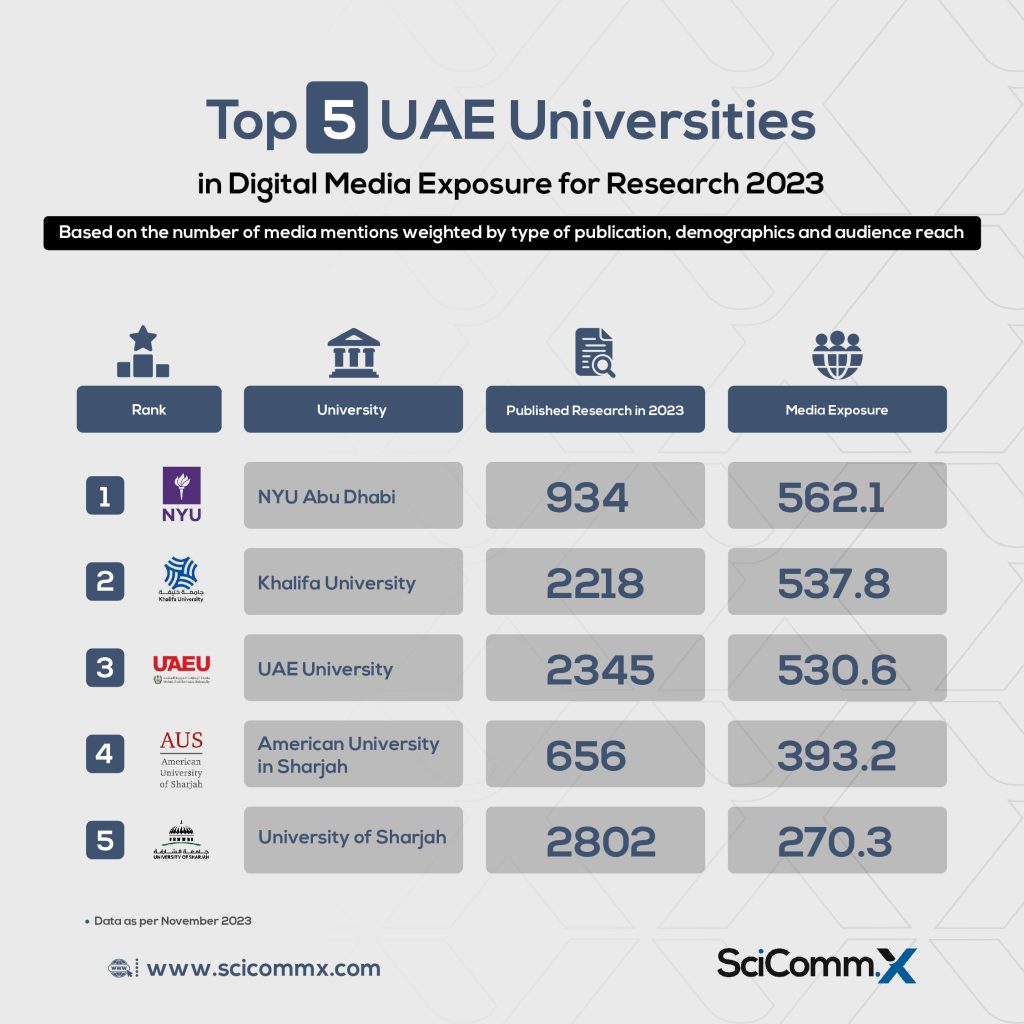Top 5 UAE Universities in Media Ranking for Research 2023

By Saad Lotfey, CEO SciComm X
Over the past years, the United Arab Emirates has emerged as one of the best hubs in the Middle East for Academic Excellence, especially in the realm of Research. In 2018, The UAE increased its expenditure on research and development from 0.9% to 1.30% of GDP. Following the increased interest in research advancement, the UAE witnessed a surge in the number of research papers by 22.7% in 2022, reaching 16,165 published documents, making it the 4th in the Arab Country Ranking for published research.
As a result of pushing for more advancement in research, UAE universities started to show interest in communicating their research, reaching a broader audience to raise awareness, developing partnerships, and supporting policy makers in evidence-based decision making. In this blog, we will analyze the media impact of UAE Universities when it comes to communicating their research based on Media Mentions, Media Exposure, and International Recognition Weight.
Our Methodology
We have gathered and analyzed data from SciVal and Newsflo (both owned by Elsevier) that track and monitor research activities based on the Scopus database. SciVal tracks the media impact of research based on the news articles published in English in digital media outlets listed in LexisNexis Metabase online news. LexisNexis filter the mass media based on 5 tiers indicating the media source as follows: Internationally recognized, Regionally recognized, Nationally, Locally recognized, and Local interest.
Then we created a list of UAE Universities that published over 500 research papers in 2023, as of November 2023, then compared the media recognition for their research based on 3 metrics:
- Media Mentions: Number of mentions in the media received by the University.
- Media Exposure: The number of media mentions weighted by type of publication, demographics, and audience reach. The weighting is assigned based on the source tier:
a. Internationally recognized = total count of Mass Media in that tier x1
b. Regionally recognized = total count of Mass Media in that tier x0.5
c. Nationally recognized = total count of Mass Media in that tier x0.3
d. Locally recognized = total count of Mass Media in that tier x0.2
e. Local interest = total count of Mass Media in that tier x0.1 - International Recognition: The number of mentions in the international media
We rank the top 5 UAE Universities based on their performance in terms of mass media mentions, International recognition, and media exposure index. However, if we would select one metric as representative of the ranking, it would be the Media Exposure Index, as it presents an index based on the weight of each type of publication, demographics, and audience, which is better and more effective than the total number of mentions or the international mentions only.
Top 5 UAE Universities in International Media Recognition for Research 2023

Khalifa University tops the list of the universities that received international media coverage for its research in 2023. Khalifa University, which has published 2218 papers in 2023 so far, received 41 mentions in International Media, followed by New York University Abu Dhabi, which received 30 international mentions. The UAE University comes in 3rd place, as UAEU received 21 international mentions. The University of Sharjah ranked 4th for receiving 10 international mentions, and in 5th place is the American University of Sharjah, which received only 2 international mentions.
Digital Mass Media Ranking 2023

For the total digital mass media mentions for research in international, regional, national, and local media outlets, New York University ranked 1st with 2121 total mentions, followed by Khalifa University with 1937 total mentions, then UAE University with 1830 total mentions, then American University of Sharjah with 1430 total mentions, and University of Sharjah with 918 total mentions. It is worth mentioning that most of these mentions are identified in local and national media with less representation for regional and international mentions.
Digital Media Exposure for Research 2023

Media Exposure is calculated as the number of media mentions weighted by type of publication, demographics, and audience reach, making it the most reliable classification for us when ranking universities based on the media coverage for their research.
New York University topped the list with a media exposure index of 562.1, followed by Khalifa University with an average of 537.8, UAE University with an average of 530.6, then American University of Sharjah with a score of 393.2, and the University of Sharjah with an index of 270.3.
Both New York University and Khalifa University are leading the ranking as they are investing heavily in promoting their research on both national and international levels. For example, Khalifa University recently published a dedicated digital magazine, “KUST Review,” to promote their research and researchers in both English and Arabic. NYU Abu Dhabi has a dedicated unit for Research Public Engagement besides their activities in promoting the latest research on the University website.
Mohamed Bin Zayed University of Artificial Intelligence
Although we excluded Mohamed bin Zayed University of Artificial Intelligence (MBZUAI) from the list, as it published only 364 papers in 2023, The university has scored outstanding media results compared to the universities in our top 5 list and the number of published research. MBZUAI has received 1553 total media mentions, with a media exposure index of 376.2. If we removed the requirement to publish over 500 papers, MBZUAI would rank 4th and 5th in media mentions and media exposure index among UAE universities.
Enhancing the Media Exposure for Research
The media impact is an essential metric that helps universities showcase the engagement of broader public audiences, gain an understanding of which research outputs grab the media’s attention, discover media outlets that are discussing an institution’s outputs, understand the level of global exposure mentioned outputs received, provide an early indication of the interest in output that has recently become available, and gain an understanding of the relative impact an institution’s research outputs have on the media. However, many institutions still struggle to develop and execute a strategic plan to enhance their media exposure for published research. These are a number of proposed recommendations that could be followed to increase the media impact of the research.
- Focus on the top 1% and top 10% of published research
It’s extremely challenging for media officers and research communicators to focus on every published research, especially at Universities that publish +1,000 papers annually. Instead, we recommend focusing on the published research in the top 1% and 10% of journals as they usually grab media attention more easily. Offering embargoed press releases with planned interviews through mediums like “EurekAlert!” could be encouraging to journalists who are in a race to be among the first publishers.
- Use Video Abstracts for the top 1% of research
Video abstracts have shown a positive effect on published research. Creating and publishing a video abstract for a high-quality research paper could lead to a 140% increase in Altmetric Scores and 80% more article views. Media also prefers publishing multimedia content, so whenever you can provide a stand-alone video abstract with a Creative Commons licence, most media will be interested in publishing it through their outlets. The video abstract could be a videographic style, illustration, interview, zoom style, animation, or whatever style matches the research’s nature and the desired platform.
- Create a media network based on the topic
Press Releases are dead for many media outlets, and they barely pay attention to them. Alternatively, universities should invest in building a network of credible science journalists in different fields and keep in touch with them so whenever there’s a piece of worthy news, the journalists can cover it as long as it’s aligned with their preferences.
- Personalized Pitching to journalists
After creating a network of journalists, Universities shall consider personalized pitching based on the topic, media outlet, and demographics instead of sharing the press release with everyone on the list. Offering personalized experiences with additional add-ons, like arranging interviews or offering extra comments, will receive more attention than sharing the press release with all journalists in the database.
- Offer quotes, comments and supporting material quickly
Whenever publishing the press release about the new research, there should be contact details for the leading researcher or the media office for further questions and inquiries. Usually, journalists need more information and have further questions about the topic; offering quotes or comments and supporting materials will be beneficial in many ways, not only in covering university research but also in seeking university experts’ comments when covering research from other institutions. Offering extra comments and responses to questions quickly is a crucial hack as journalists usually have tight deadlines, and most prestigious media outlets will only publish a story with comments from the authors dedicated to the publication.
- Organize Media Training for your researchers
One of the challenges that we identified based on our work with many universities is the gap between researchers and journalists. Many researchers struggle to build meaningful connections with journalists, respond to their questions or highlight the value of their work in a way that the public can understand. That’s why universities should invest in media and research communication training programs for their researchers to make sure that they share clear, concise, and impactful messages.
This article is part of our SciComm X research media ranking series, which aims to highlight the importance of promoting research from the Arab world and the new engagement initiatives launched by universities and research centers in the region.
